Advanced Hot Fat Sparks
![]()
Advanced Hot Fat Sparks |
|
How I Installed a CDI in my Falco
by Jonas Dovydenas
|
This article appeared in the June 2006 issue of the Falco Builders Letter. |
Several years ago my Falco was approaching 1300 hours on the tach. A mechanic I trust told me this is about the time that magnetos begin to fail. Since Slick magnetos cannot be rebuilt, they have to be replaced with new ones. I remember being horrified when I saw what was inside that deceptively sturdy looking black case—little plastic gears going round and round and ancient automotive points madly opening and closing, sending feeble 12 volt pulses through the primary winding, hoping to get the secondary to kick it up to 17,000 volts, if everything worked as it should…
That made me think. All you ever read in aviation articles is never to bet on the reliability of a magneto, yet I don’t know anyone who has had a magneto failure that resulted in an emergency. One fails, the other gets you down at the next airport. So why go to the trouble of installing an electronic ignition? There are many good reasons, all you have to do to find your own favorites is Google ‘aircraft ignition’. That was in the beginning for me.
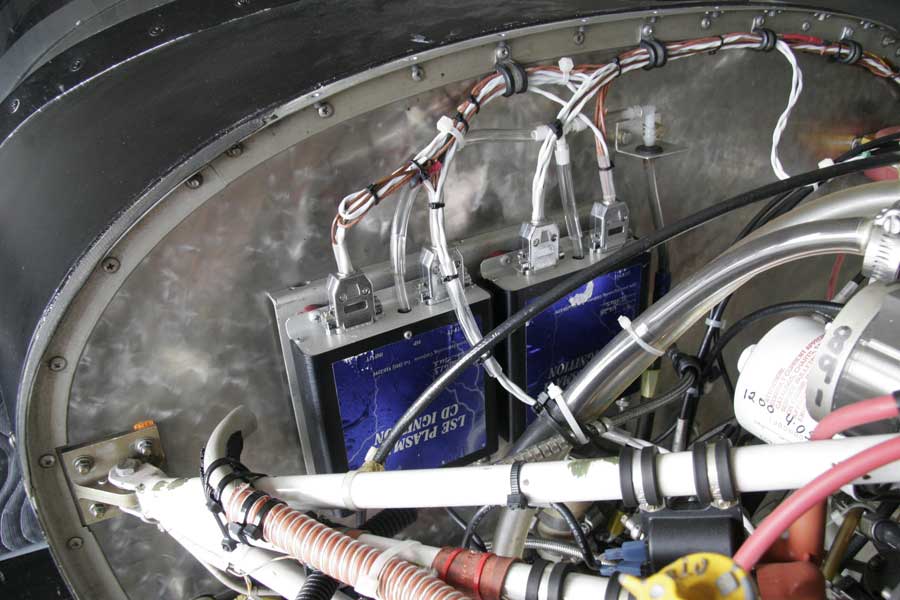
In the end it was out of pure spite. Two new Slicks, worth about $50 each if there was any economic justice in the world (which any Howard Dean supporter worth his spit will tell you there ain’t) will set you back almost as much as a solid state capacitative discharge ignition system that includes everything you need to bring you into a world that car ignition systems have inhabited for the last 30 years. I don’t recall the last time someone complained to me that the car stopped running because the ignition didn’t work. And cars don’t have dual systems like planes do.
I don’t know about you, but every time I get in my Falco I see the big letters XPERIMENTAL on the side, and I think What can I do today that the FAA doesn’t approve of? Well, car ignitions in airplanes was the answer to that question one day about two years ago.
The product I decided on is the Lightspeed Engineering Plasma CDI ignition system. Lightspeed claims that replacing just one magneto will give you almost all the benefits, but because I felt so strongly about magnetos, I could not just junk one without junking my principles. Both had to go.
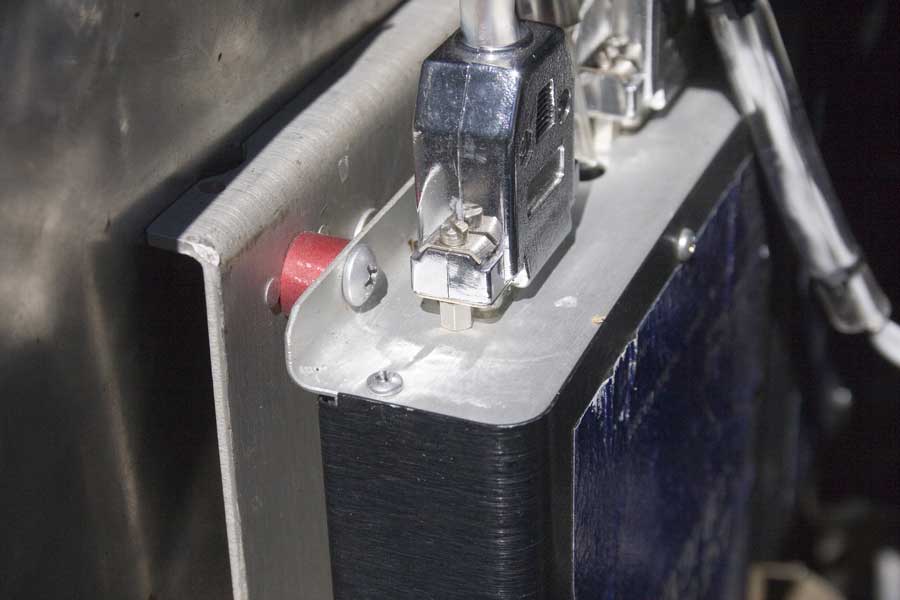
In a Falco there is not much room, or access, for anything until you get past frame 6. While my Falco had more than enough spare wires in the harness, the Lightspeed CDI unit came with its own wires. These would have to be incorporated into the wire bundle running from the engine to past frame 6. Too much trouble for me. A firewall installation looked a lot easier. But it was not recommended. Keep the boxes away from engine heat, said the installation instructions. I called Klaus Savier, the man who developed the product and sells it, to ask him if he could be more specific about the degree of heat to be avoided. He said his system was on the firewall without any problems, that all the components were stock mil-spec items, that cooler would be, of course, better, but don’t worry, be happy, use the firewall if you have room and some cooling air. Or words to that effect.
The problem with mounting the two boxes on the firewall was that it wasn’t as simple as putting the Sawsall to my spar when I installed the swing wing. I could just drill some holes in the firewall, which would have been easy enough if I wanted to use wood screws, but I did not. (One reason, among others, is that once you had wood screws showing, their slots all have to line up or you got points off at Oshkosh, by gosh.) I decided to bolt a plate, a doubler, on the firewall in the area on the right side intended for the inverted oil tank, and mount the units to that.

Unless your Falco is still under construction, to get to the back of the firewall you have to remove the instrument panel and the fuel tank. This is not difficult, but a little tedious, compared to, say, flying to Maine on a sunny day for a lobster lunch, and doing a couple of rolls along the way for the crowd of earth crawlers on the top of Mt. Monadnock.
After I took out the fuel tank I found a construction error. The hex heads of the motor mount fasteners were not safety wired, nor did I use one of those locking channels. For some reason the occasional slight tightening of the nut on the firewall side did not turn the bolt as well. So I never knew that I had made a possibly serious mistake until the tank came out. [Jonas is in error here, there is no requirement for safety wire on these bolts, only on the bolts that attach to the engine.]
An alternative if you are in the early stages of construction is to put both boxes behind frame 6. The equipment is not heavy, including the 5 or 7 AH battery, but it does lighten the nose when the heavy magnetos are replaced by light aluminum sensors. (I have never had a problem with aft CG. The more the better, is how I look at it. Once I had about 75 lbs. of luggage, two cases of wine, if you want to know, a full tank and my wife on a warm day on a short strip and, guess what, the Falco mushed and wiggled its tail like a lazy guppy before deciding to climb. That was all.)
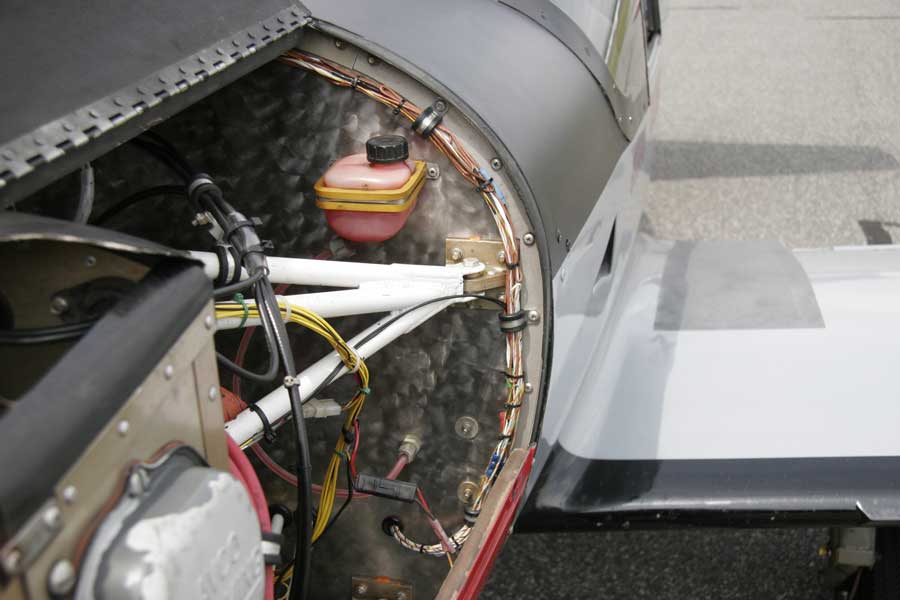
The CDI ignition uses motorcycle spark plugs. If you go to the nearest Harley dealer you can go hog wild and spend as much as $15 each for platinum wire plugs, if you don’t like the ordinary ones for about $3 each. And I’m not cheap, I just don’t like to spend money.
The system is connected to a source of engine vacuum and responds to manifold pressure and RPM, in other words, to engine power. At idle the plugs fire at 42 degrees before TDC. On take-off, the advance is around 28 degrees. In cruise, at 22” of manifold pressure and 2350 RPM the plugs fire at 32 degrees BTDC. Varying the ignition advance according to the manifold pressure makes the engine more efficient.
There are other factors in favor of increased engine performance. The magneto puts out a voltage in proportion to RPM. Thus, to start the engine, one magneto has to have its armature snapped forward to put out sufficient voltage. This is accomplished by springs and levers—another stone age gizmo. Or the “shower of sparks” from a different, equally primitive device.
Electronic ignition, on the other hand, supplies 36,000 volts to a huge spark gap (.037”) no matter what the rpm. Moreover, both units use a default setting of zero degrees TDC when the engine is not making vacuum in the intake manifold. Thus, my engine starts in less than one revolution. A bigger spark plug gap, a fatter spark makes for a more positive ignition of the fuel mixture. During a run-up there is no drop in RPM as each side is turned off and on. In cruise, there is a slight increase in engine vibration and a decrease in speed.
The fat spark and advanced firing make possible running the engine on the lean side of peak. This way of operating is not recommended by Lycoming, but it works; the engine runs smoothly (up to a point where the first cylinder begins to missfire) and all the temperatures drop significantly. For me, with my IO-360, there is a slight speed penalty to operating lean of peak, but a big gain in how much expensive burned avgas goes out the exhaust pipes.
Lightspeed does not recommend using an existing Bendix starter/ignition switch. You may recall that the ignition switch disconnects the P-lead from the magneto. The CDI unit is the other way around—a connection must be made, not broken. Despite frowning on it, Lightspeed tells you how to re-wire the Bendix switch so it works with its unit. I consider that to be a big plus for anyone with a standard Sequoia panel. I didn’t see a nice way to replace the Bendix switch with two toggle switches and a push button somewhere else on the panel. Taking the Bendix switch out would also leave a big hole, though I suppose it could be left in place and only used as a starter switch.
But there is an elegant solution to installing the ignition read-out panel and emergency battery switch. The marker beacon bright/dim switch (S26) is in my panel but not used. It is a transfer switch. Next to it is an orange light, also not used but intended for the marker beacon, which I don’t have. Next to S26 there is enough room to install the small readout panel that displays the ignition advance of each unit in degrees, manifold pressure, and RPM. It’s an accessory worth buying since it is one of the best features of the system. With it, you can read spark advance of each unit within one degree of resolution, and the information is available in flight. It’s a very cool setup.
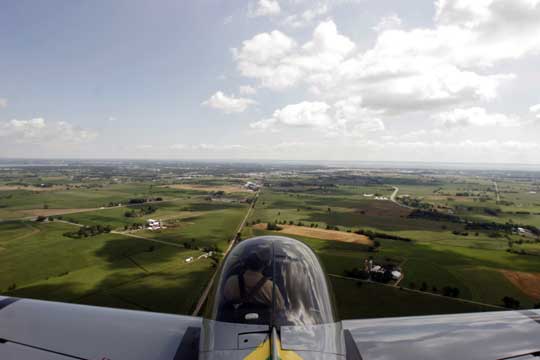
Approaching Oshkosh
In the “down” position of the switch, the current flows from the main electrical system, through the Bendix switch to the left ignition unit. When the switch is flipped up, current flows from a small five AH battery and powers the right side unit, the orange light next to the switch, and the Davtron. I did this because the Davtron temperature indicator unit also displays voltage and draws very little current. With the electrical system shut off, I have over one hour and thirty minutes before the battery crashes. I can tell you from having done it—the Falco flies almost as smoothly as with both sides firing. I have flown this way and after an hour the battery the voltage had gone down to 11.2 v. According to Lightspeed Engineering, their system will work from four to 32 volts. According to the specs of the battery, after it discharges slowly down to 10.5 volts it will drop to four volts almost immediately. This battery is connected to the main electrical system through a diode, thus allowing it to accept a charge from the main system, but blocking a discharge back into the main system when all power is shut off.
Lightspeed Engineering provides a choice of ways to generate the primary ignition signals: mounting a magnet on the engine to sense a small piece of metal bolted to the flywheel or installing the so-called Hall Effect sensor in place of the magneto. These are small aluminum cylinders that go in place of the mags and are held by the existing mag clamps. This made sense to me and that is what is in my Falco. These units have a little green light on the back which lights up when the timing is correctly adjusted.
These units come without a drive gear, so you have to take the drive gear off the magneto. The magneto with the impulse coupling mechanism has a different gear that can’t be used. A gear from Lycoming will set you back—you wouldn’t believe it if I told you. But a junkyard in Arizona had a gear with a little surface corrosion on several of the teeth for $35, which is just as outrageous since the surface discoloration made that gear unairworthy. The rotating magnet in the Hall effect sensor has very little mass, unlike the junk grinding away inside a magneto, so I decided I was comfortable in assuming the gear from the junkyard would last longer than I would. And, of course, the gear on the other unit was like new—an acceptable plan B as far as I was concerned.
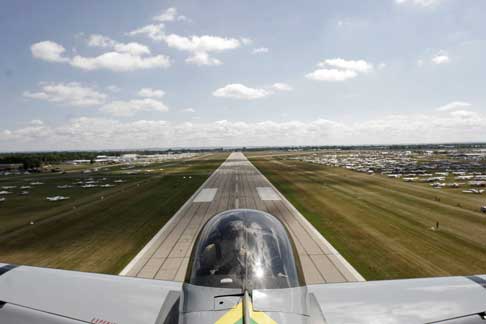
Conclusion. The engine starts more easily, there is a slight increase in power during takeoff (a steeper climb), the engine runs a little more smoothly, the cylinder temperatures are lower. I have enough data to quantify a comparison from a number of test flights, but frankly, I don’t have much enthusiasm (never did) for organizing the data into a presentable narrative, but the system works as advertised. Lightspeed Engineering has a good website (www.lightspeedengineering.com) as do some of the other vendors. It’s worth reading all the information before committing to a new way of thinking about your Falco’s ignition.
The quality of the components is good, the installation instructions are okay but nowhere close to what you we are used to from Sequoia. There were occasions of minor confusion on my part but when I called Klaus Savier, the man who makes and sells Plasma CDI. He did not always seem very interested in deconfusing me. Perhaps dim instruction manuals generate dumb questions.

Jonas Dovydenas
|
|